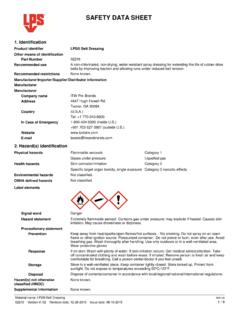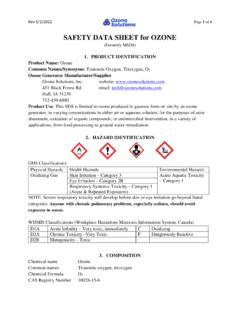Transcription of MATERIAL SAFETY DATA SHEET - Dawson …
1 MATERIAL SAFETY data SHEET CAST STEEL ABRASIVES Date of Preparation: October 5, 2009 Section 1. PRODUCT IDENTIFICATION. Product Name: Steel Shot, Steel Grit, Manufacturer: Wheelabrator Abrasives, Inc. Steel Shot/Grit blend. 1 Abrasive Avenue Bedford, Virginia 24523 USA Chemical Name: Steel Chemical Family: Metals Formula.
2 Not Applicable (N/A) Emergency Phone: (540) 586-0856 _____ Section 2. HAZARDOUS INGREDIENTS. Round or angular steel pellets used primarily for impact treatment of metallic surfaces. There are no threshold limit values (TLV) or permissible exposure limits (PEL) for cast steel abrasives. CHEMICAL NAME CAS NUMBER % WEIGHT ACGIH LEVEL (mg/m3) OSHA PEL (mg/m3) Iron Fe Oxide & Fume, as Fe 7439-89-6 >95 5 10 Manganese Mn Inorganic compounds, as Mn Fume, as Mn 7439-96-5 < 5 (ceiling) 5 (ceiling) Silicon Si Total Dust Respirable Fraction 7440-21-3 < 10 15 5 Carbon C 1333-86-4 < Chromium Cr Metal Cr II compounds, as Cr Cr III compounds, as Cr Cr VI compounds, water soluble Cr VI compounds, insoluble 7440-47-3 < Nickel Ni Metal & other compounds, as Ni Elemental Soluble inorganic compounds Insoluble inorganic compounds 7440-02-0 < 1 Note: This product is manufactured from recycled steel scrap and may contain hazardous materials not listed above.
3 The following is a list of typical chemicals that may be found in recycled steel scrap (this list is not all inclusive): aluminum, antimony, arsenic, bismuth, cadmium, chromium, cobalt, copper, lead, magnesium, molybdenum, nickel, phosphorus, potassium, selenium, sodium, sulfur, tin, vanadium, zinc. _____ Section 3. PHYSICAL data . Melting Point: 1371-1482 C Vapor Pressure: Not applicable Vapor density: Not applicable Solubility in water: Negligible Specific gravity: > 7 g/cc % Volatile: N/A Evaporation rate: N/A Appearance and odor: Metallic gray to blue odorless spherical and/or angular pellets.
4 _____ Section 4. FIRE AND EXPLOSION HAZARD data . Flash Point: Not applicable Flammable limits: Not applicable Autoignition Temperature (of solid iron exposed to oxygen): 930 C Extinguishing media: Select media appropriate for the surrounding area, including dry chemical, soda ash etc. Note: Do not use water, CO, or form of Iron Oxide fume/dust materials. Unusual fire and explosion hazards: Dusts generated from use may be explosive. Special fire fighting equipment: Dry chemicals, dry sand, soda ash or lime. _____ Section 5. REACTIVITY data .
5 Stability: Stable Incompatibility: Strong Acids Hazardous Polymerization: Not applicable Conditions to avoid: None WA002 USA 09/09 Section 6. HEALTH HAZARD data . There is no applicable statutory or recommended occupational exposure limits for cast steel abrasives. However, operations that elevate the temperature of the product or the dust to above its melting point, generate metal fumes and result in the breaking down of the product into dusts may present hazards.
6 These operations should be performed in well-ventilated areas. The major exposure hazard is inhalation. Inert or nuisance dust: OSHA PEL: Respirable fraction: 5 mg/m3 Total dust: 15 mg/m3 Carcinogenicity: Chromium and Nickel are confirmed human carcinogens according to the ACGIH. Carbon and Nickel are potential occupational carcinogens according to the NIOSH Pocket Guide to Chemical Hazards.
7 The NIOSH Pocket Guide to Chemical Hazards list the following symptoms for chronic or prolonged inhalation of fumes or dust: Iron oxide: Benign pneumoconiosis with X-ray shadows indistinguishable from fibrotic pneumoconiosis (siderosis). Manganese: Parkinson's; asthenia, insomnia, mental confusion; metal fume fever: dry throat, cough, chest tightness, dyspnea (breathing difficulty), rales, flu-like fever; lower back pain; vomiting; malaise (vague feeling of discomfort); fatigue; kidney damage. Silicon: irritation eyes, skin, upper respiratory system; cough.
8 Carbon: cough, irritation eyes. Chromium: irritation eyes, skin; lung fibrosis (histologic); sensitization dermatitis. Nickel: sensitization dermatitis, allergic asthma, pneumonitis. Copper: irritation eyes, upper respiratory system, nose, pharynx; nasal septum perforation; dermatitis; metal fume fever: chills, muscle ache, nausea, fever, dry throat, cough, weakness, lassitude (weakness, exhaustion); metallic or sweet taste; discoloration skin, hair. Lead: weakness, lassitude (weakness, exhaustion), insomnia; facial pallor; anorexia, weight loss, malnutrition; constipation, abdominal pain, colic; anemia; gingival lead line; tremor; paralysis wrist, ankles; encephalopathy; kidney disease; irritation eyes; hypotension.
9 _____ Section 6a. EMERGENCY AND FIRST AID PROCEDURES. If inhaled, move to fresh air, and if symptoms persist, consult a qualified medical person. If shot, grit or dust particles get in the eyes, flush eyes with running water for at least 15 minutes and have any remaining particles removed from eyes by a qualified medical person. Wash with soap and water after contact with dust. _____ Section 7. SPILL OR LEAK PROCEDURES. Shot and/or grit spilled or leaked onto floors can create hazardous walking conditions. In case MATERIAL is released or spilled, sweep up and collect for reclamation or disposal.
10 Waste disposal method: the MATERIAL may be reused or disposed of in sanitary landfills in compliance with local, federal and state regulations. The dust generated by the use of the MATERIAL may be classified as hazardous and therefore must be disposed of according to local, federal and state regulations. _____ Section 8. SPECIAL PROTECTION INFORMATION. Ventilation: adequate ventilation and exhaust of the dust and fumes generated during operations should be provided to reduce the exposure levels. Respiratory protection: NIOSH approved respirator is recommended.















